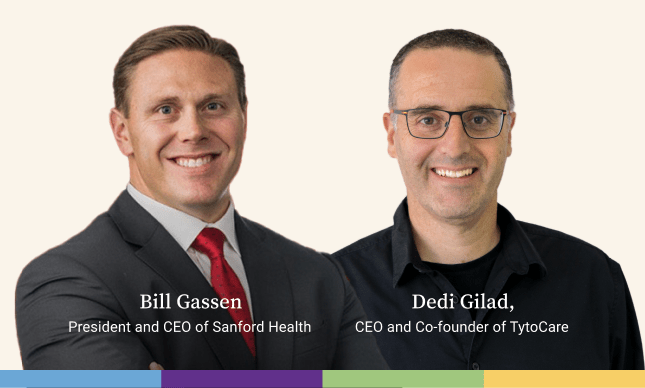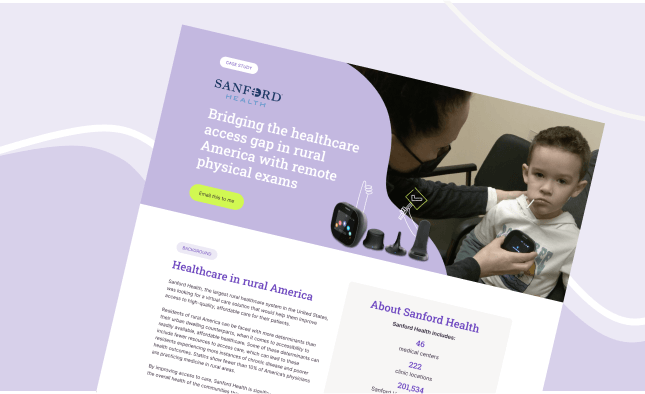From school to rural: How to create effective, scalable telehealth programs
Hear from school healthcare experts on how they have built their school telehealth programs to increase utilization and provide high-quality care, while cutting costs.
Speakers

Mandy Bell
Vice President of Product Innovation

Dr. Stormee Williams
VP and Chief Health Equity Officer
Key insights:
- Telehealth programs can be highly beneficial in rural areas and schools where access to healthcare can be limited.
- The success of telehealth programs often depends on the dedication and belief of on-site healthcare providers such as school nurses.
- Telehealth programs can help in reducing unnecessary visits to emergency rooms and can provide timely care for students and rural communities.
- The implementation of telehealth programs can vary in time depending on the size of the school district and the level of buy-in from the school community.
- Training for telehealth programs should be simple and quick, allowing healthcare providers to focus on patient care.
- Telehealth programs can also provide reassurance to healthcare providers by allowing them to consult with colleagues virtually.
Telehealth programs have significant potential in rural areas and schools
In the webinar, the panelists discussed the potential of telehealth programs in addressing challenges in rural areas and schools. Dr. Stormee Williams and Mandy Bell shared their experiences in implementing such programs and highlighted the benefits they have seen in terms of improved access to care, cost savings, and overall patient outcomes. Dr. Williams described the telemedicine program she helped implement in over 220 schools: “We have a model where if the school district thinks that school telehealth can help, we do our best to go into that school district to provide services.” She further emphasized the impact of such programs, “One school district said that we were able our program was able to save them, five hundred thousand dollars in funding just from keeping kids in school.” Bell emphasized the role of telehealth programs in supporting rural healthcare providers and facilities: “We see our services as a part of a staff member or partial FTE that’s assisting that facility. We’ve tried to apply that discipline across all of our service lines to really figure out how the right blend of technology and clinical expertise and service will best suit the needs of the different clients for serving.”We like to think that telehealth can be a win for everybody involved. It’s really about connecting patients to the care they need when they need it.

Mandy Bell
Vice President of Product Innovation
Technology plays a vital role in telehealth programs
The panelists discussed the importance of technology in delivering telemedicine services. They highlighted the role of diagnostic tools in enhancing their ability to provide care and the convenience and ease-of-use these tools bring to both patients and providers. Dr. Williams expressed her preference for telemedicine visits that utilize digital diagnostic equipment: “I feel most comfortable and confident in my exam when I can use digital diagnostic equipment because that is what’s most like, what I would do in the office.” Bell echoed this sentiment, emphasizing that technology should be so easy to use that it fades into the background and lets the care team shine.The benefit of being able to look in the ear and look in the nose and listen to lungs, just adds to that level of confidence that I have in making a diagnosis and also, coming up with the treatment plan.

Dr. Stormee Williams
VP and Chief Health Equity Officer
Telehealth programs require strong relationships and streamlined processes for effective implementation
Both panelists emphasized the importance of building strong relationships with key stakeholders and streamlining processes for the successful implementation and scaling of telehealth programs. Dr. Williams emphasized the importance of relationships when starting a school-based program. She noted, “When the nurse comes to us and initiates it and says our students need this. It really takes off… our nurse is our champ if they believe in the program and have the capacity to do it, it is very successful.” Bell also noted the importance of streamlining processes and providing a standard experience for sites to ensure a good implementation experience: “We’ve really streamlined processes so that we know that the sites are having a good experience and understanding of telehealth.”The nurse is our champ. If they believe in the program and have the capacity to do it, it is very successful.

Dr. Stormee Williams
VP and Chief Health Equity Officer
Learn more
Blog

Tackling staff shortages in rural areas with virtual care
Rural America is disproportionally underserved when it comes to healthcare due to staff shortages and a lack of access to quality services. This blog post explores how virtual care can be leveraged as a solution to combat these staff shortages, providing improved convenience and cost-effectiveness for those living in rural areas. Overview of rural America’s […]
Webinar

The role of telehealth in the future of excellent healthcare for rural areas
Health systems across the United States are investing in a continuous effort to provide equally high-quality healthcare across the regions they cover. This can be challenging when dealing with communities in rural areas, where the current shortage of clinicians adds to existing difficulties in making coverage hard to access. As they strive to provide affordable […]
